Simultaneous tDCS-fMRI Identifies Resting State Networks Correlated with Visual Search Enhancement
- PMID: 27014014
- PMCID: PMC4779888
- DOI: 10.3389/fnhum.2016.00072
Simultaneous tDCS-fMRI Identifies Resting State Networks Correlated with Visual Search Enhancement
Abstract
This study uses simultaneous transcranial direct current stimulation (tDCS) and functional MRI (fMRI) to investigate tDCS modulation of resting state activity and connectivity that underlies enhancement in behavioral performance. The experiment consisted of three sessions within the fMRI scanner in which participants conducted a visual search task: Session 1: Pre-training (no performance feedback), Session 2: Training (performance feedback given), Session 3: Post-training (no performance feedback). Resting state activity was recorded during the last 5 min of each session. During the 2nd session one group of participants underwent 1 mA tDCS stimulation and another underwent sham stimulation over the right posterior parietal cortex. Resting state spontaneous activity, as measured by fractional amplitude of low frequency fluctuations (fALFF), for session 2 showed significant differences between the tDCS stim and sham groups in the precuneus. Resting state functional connectivity from the precuneus to the substantia nigra, a subcortical dopaminergic region, was found to correlate with future improvement in visual search task performance for the stim over the sham group during active stimulation in session 2. The after-effect of stimulation on resting state functional connectivity was measured following a post-training experimental session (session 3). The left cerebellum Lobule VIIa Crus I showed performance related enhancement in resting state functional connectivity for the tDCS stim over the sham group. The ability to determine the relationship that the relative strength of resting state functional connectivity for an individual undergoing tDCS has on future enhancement in behavioral performance has wide ranging implications for neuroergonomic as well as therapeutic, and rehabilitative applications.
Keywords: fMRI; functional connectivity; neuroergonomics; resting state; tDCS; visual search.
Figures
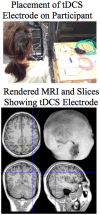

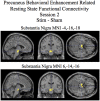
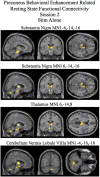
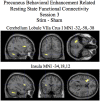
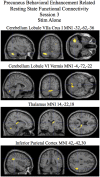
Similar articles
-
Individual differences in learning correlate with modulation of brain activity induced by transcranial direct current stimulation.PLoS One. 2018 May 21;13(5):e0197192. doi: 10.1371/journal.pone.0197192. eCollection 2018. PLoS One. 2018. PMID: 29782510 Free PMC article.
-
Effects of Transcranial Stimulation With Direct and Alternating Current on Resting-State Functional Connectivity: An Exploratory Study Simultaneously Combining Stimulation and Multiband Functional Magnetic Resonance Imaging.Front Hum Neurosci. 2020 Feb 5;13:474. doi: 10.3389/fnhum.2019.00474. eCollection 2019. Front Hum Neurosci. 2020. PMID: 32116597 Free PMC article.
-
Cerebellar transcranial direct current stimulation reconfigurates static and dynamic functional connectivity of the resting-state networks.Cerebellum Ataxias. 2021 Feb 24;8(1):7. doi: 10.1186/s40673-021-00132-6. Cerebellum Ataxias. 2021. PMID: 33627197 Free PMC article.
-
Predicting Working Memory Training Benefits From Transcranial Direct Current Stimulation Using Resting-State fMRI.Front Psychol. 2020 Oct 14;11:570030. doi: 10.3389/fpsyg.2020.570030. eCollection 2020. Front Psychol. 2020. PMID: 33154728 Free PMC article.
-
Frontopolar tDCS Induces Frequency-Dependent Changes of Spontaneous Low-Frequency Fluctuations: A Resting-State fMRI Study.Cereb Cortex. 2022 Aug 3;32(16):3542-3552. doi: 10.1093/cercor/bhab432. Cereb Cortex. 2022. PMID: 34918029 Clinical Trial.
Cited by
-
Simultaneous fMRI and tDCS for Enhancing Training of Flight Tasks.Brain Sci. 2023 Jul 3;13(7):1024. doi: 10.3390/brainsci13071024. Brain Sci. 2023. PMID: 37508957 Free PMC article.
-
Individual differences in learning correlate with modulation of brain activity induced by transcranial direct current stimulation.PLoS One. 2018 May 21;13(5):e0197192. doi: 10.1371/journal.pone.0197192. eCollection 2018. PLoS One. 2018. PMID: 29782510 Free PMC article.
-
Effects of transcranial direct current stimulation on modulating executive functions in healthy populations: a systematic review and meta-analysis.Front Hum Neurosci. 2024 Dec 13;18:1485037. doi: 10.3389/fnhum.2024.1485037. eCollection 2024. Front Hum Neurosci. 2024. PMID: 39734667 Free PMC article.
-
Lattice layout and optimizer effect analysis for generating optimal transcranial electrical stimulation (tES) montages through the metaheuristic L1L1 method.Front Hum Neurosci. 2024 Feb 29;18:1201574. doi: 10.3389/fnhum.2024.1201574. eCollection 2024. Front Hum Neurosci. 2024. PMID: 38487104 Free PMC article.
-
Resting-State Activity Changes Induced by tDCS in MS Patients and Healthy Controls: A Simultaneous tDCS rs-fMRI Study.Bioengineering (Basel). 2025 Jun 19;12(6):672. doi: 10.3390/bioengineering12060672. Bioengineering (Basel). 2025. PMID: 40564489 Free PMC article.
References
LinkOut - more resources
Full Text Sources
Other Literature Sources

